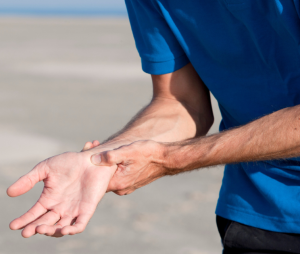Carpal Tunnel Release: What to Expect After Surgery
 Carpal tunnel syndrome (CTS) is one of the most common disorders treated at Orthopaedic Hospital of Wisconsin. It is characterized by hand numbness and tingling in the fingers. These symptoms can gradually increase to a sensation of burning, pain, or weakness. This is a widespread phenomenon and is one of the most pervasive nerve disorders. Carpal tunnel syndrome affects millions of Americans per year.
Carpal tunnel syndrome (CTS) is one of the most common disorders treated at Orthopaedic Hospital of Wisconsin. It is characterized by hand numbness and tingling in the fingers. These symptoms can gradually increase to a sensation of burning, pain, or weakness. This is a widespread phenomenon and is one of the most pervasive nerve disorders. Carpal tunnel syndrome affects millions of Americans per year.
If you need relief from carpal tunnel syndrome, the specialists at OHOW are here to help. Thankfully, carpal tunnel is very treatable by our hand and wrist specialists. However, it is vital to seek treatment before permanent nerve damage occurs.
For some, CTS can heal on its own with the assistance of wearing a splint or taking an extra step to include cortisone injections for effective and temporary relief. For ongoing problems, surgery can help provide a more permanent solution.
If you consider surgery to alleviate the symptoms of carpal tunnel syndrome, the specialists at Orthopaedic Hospital of Wisconsin want you to know what to expect after surgery. In the blog post below, Dr. John C. Wu, MD of Hand to Shoulder Specialists of Wisconsin, discusses the carpal tunnel release procedure and what to expect in the healing process.
What is Carpal Tunnel Release Surgery?
 Carpal tunnel surgery, known as a “carpal tunnel release,” involves an incision through the transverse carpal ligament. This incision makes the ligament bigger and improves blood flow. The result of the procedure eases nerve pressure and improves nerve conduction in the wrist.
Carpal tunnel surgery, known as a “carpal tunnel release,” involves an incision through the transverse carpal ligament. This incision makes the ligament bigger and improves blood flow. The result of the procedure eases nerve pressure and improves nerve conduction in the wrist.
The goal of this surgery is to prevent permanent damage or weakness and improve nerve pain. The surgery may also improve nerve sensation.
There are several different techniques surgeons use for carpal tunnel release—either the traditional open method or a minimally invasive endoscopic procedure. The procedure typically only takes about 10-15 minutes and involves a small incision on the palm or wrist.
Surgical results of both procedures are commonly the same at 12 months post-surgery. The minimally invasive manner often has a slightly faster initial recovery time. After carpal tunnel surgery, most patients experience a full recovery and a return to regular, comfortable activities.
Post-Operative Expectations After Carpal Tunnel Release
Removes Numbness
Carpal tunnel release improves the symptoms of numbness for nearly every patient. Complete and total relief of all symptoms depends upon the severity of symptoms before surgery. Total relief may only occur in half of patients.
 Reduction of Throbbing Nerve Pain
Reduction of Throbbing Nerve Pain
Post-operatively, the reduction of throbbing nerve pain is the first noticeable improvement. It is apparent from the first few days or several months after surgery. The next notable improvement is typically a decrease of numbness and improved sensation. Recovery will take several months, as the nerve needs time to regenerate and heal. This healing period varies by person, but nerves typically heal about one inch per month.
Recovery of Motor Skills and Strength
The recovery of motor skills and strength will occur much later and depend upon the severity of symptoms before surgery. If significant muscle wasting or paralysis occurred within the hand before surgery, this indicates that there may not be any significant improvements after surgery. Subtle weakness may improve after many months and up to years after the procedure.
Overall, the maximum benefit of carpal tunnel release may take up to 6 months to 1 year after surgery. The healing process of your incision will also coincide with the healing of your released carpal tunnel.
Carpal Tunnel Release Potential Complications
Surgical Wound Infection
As with any surgery, there is room for potential complications. Infections are rare but have the potential to occur with improper wound care. Infection can cause wound dehiscence or the reopening of the surgical incision. Depending on the severity, the issue is treated with antibiotics and local wound care or requires additional surgery.
To prevent infection, keep the incision clean and dry and minimize sweating, gripping, or any activity that may compromise the incision. Be sure to follow the post-operative instructions provided by your doctor.
Pillar Pain
Pillar pain occurs along your incision several months after surgery, even after the incision has healed. This pain may originate from tenderness of the prominent bony structures and released carpal ligament. If this occurs, desensitization exercises can help to diminish symptoms. Symptoms tend to improve in about six months.
Complex Regional Pain Syndrome
This condition contains severe chronic pain in the hand following surgery. Often, there is an unknown cause. Unfortunately, there is no reliable way to prevent this undesirable complication. Variations in surgical technique have not affected the occurrence of this complication. Treatment may require extensive pain and nerve therapy. Most recent data suggest that this complication has a slight chance of occurring in only 0.1% – 0.3% of cases.
Carpal Tunnel Release Recovery Process

In most cases, carpal tunnel release surgery only involves a brief time at the hospital and a light bandage. No general anesthesia nor overnight stay is required. Minimal stitches close the skin. They are removed a week later in the office.
Most patients may perform light activities like typing, writing, eating, and dressing independently the day after surgery however, it may take a few weeks to feel comfortable starting outdoor activities like biking, jogging, and gardening. Full-force activities like pull-ups and push-ups can take months to feel comfortable with. Follow the instructions provided by your doctor to know what activities are safe.
After carpal tunnel surgery, most patients experience a full recovery and a return to regular, comfortable activities.
If you are living with hand numbness, treatment begins by scheduling a visit with a hand and wrist specialist who can confirm that your condition is carpal tunnel syndrome and talk to you about treatment and potential surgery.
To make an appointment online, visit https://www.ohow.com/request-an-appointment/ or call (414) 961-6800.

